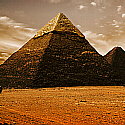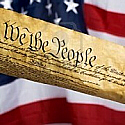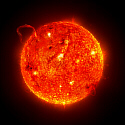Carolina Giants
From: lamarzulli.net
By: Joseph Riverwind
Macanabo’s steely gaze swept across the vast ocean horizon as if he was going to find something new that had never been seen before. As he knelt in the soft sand something was making him uncomfortable but he could not find the source of his uneasiness.
Everything seemed right; the smell of salt air came in waves with every breath of wind while the sea gulls sang their feeding songs as they hung suspended in space waiting to catch a juicy fish down below.
Slowly Macanabo stood up as the sun’s rays landed upon his thick frame. He easily stood the size of a long spear (8 feet) with a physical frame that looked as if he had been sculpted from
marble. Dark bronze skin covered him with long, straight black hair tied in a top knot and reaching down the length of his sinewy back. His broad neck was adorned with pearls which is why the men had been out this morning. His almond shaped eyes rested evenly with his chiseled nose as a middle marker. His ears were pierced with studs and solid black tattoos with various intricate designs placed on his body.
Nearby were his baira (bow and arrows) and his macana (warclub) which had seen many uses in raids against the much smaller Arawak and Lucayan people throughout the other islands. Even
though this part of the land of giants, called Chicora, were mainly pearl harvesters there were warriors who lived among them.
On this day it was the Chicora pearl divers who saw the strange canoe floating towards them from the south. Little did Macanabo know how quickly his life was going to change as the old stories of these strange men who commanded fire and thunder landed on the shores of his people.
In 1496 the Spanish had established a colony in Kiskeya (Santo Domingo) and after brutally enslaving the native Arawak population they found themselves with a shortage of slaves to
mine their gold because so many died of overworking, disease and murder. Pedro Salazar, mayor of La Concepcion, set out to find more slaves by sailing north instead of the usual east
and south from 1514-1516.
Salazar passed the Bahama Islands, ancestral lands of the Lucayan Native Americans known to them as Guanahani eventually making landfall somewhere betweenthe coast of modern day Georgia and Cape Fear. It was on an outlying island where he encountered a village of giants which
caused Salazar to name the place “The Land of the Giants”.
Salazar captured 70 giant slaves and sold them at the market in Kiskeya but he kept one who became a very well-known Native American of his time by the name of Franciso Chicora. Francisco, was over 7ft tall by oral accounts, adopted the Catholic faith and quickly learned to speak Spanish.
It was then that Francisco’s Native American oral tradition of the land, its history and
resources captivated the Spanish Crown. Francisco also spoke of Datha, another Giant King who was even taller than Francisco! Datha ruled a village of pale skinned, red haired, bearded giants off the coast of the Carolinas who would be encountered by the Spaniards in later years.
It was Francisco Chicora, the captured Native American giant, and his stories of the interior that caused the first Spanish expeditions into South Carolina to be launched which ended up with the first Spanish settlement being built in South Carolina. San Miguel de Guadalpe (1526 est.)





